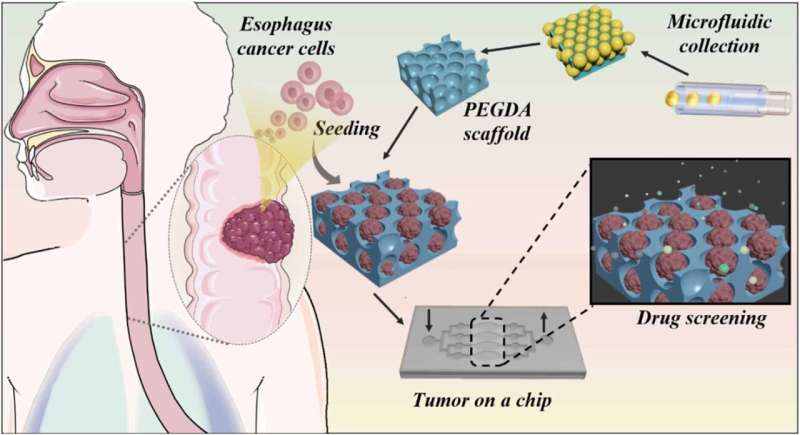This article has been reviewed according to Science X's editorial process and policies. Editors have highlighted the following attributes while ensuring the content's credibility:
fact-checked
proofread
And improved method for anti-cancer drug detection: How tiny tumor models could transform drug testing

A team of researchers from Henan University of Science and Technology have introduced a novel method for improving drug testing for esophageal cancer (EC) using advanced three-dimensional (3D) cell culture technology. The authors created a tumor spheroid model on a chip by using inverse opal hydrogel scaffolds to better mimic the in vivo environment of tumors. This innovative platform enables more accurate assessment of chemotherapeutic agents by simulating the physiological conditions that cancer cells encounter in the body.
Esophageal cancer is one of the most common cancers, causing 450,000 deaths worldwide each year. At present, surgery is the main method for treating local tumors. At the same time, for patients in advanced stages with overall poor conditions who have lost the opportunity for surgery, chemotherapy is the main treatment option.
However, the development of chemotherapy drugs for esophageal cancer is still in its early stages. Conventional drug development typically uses two-dimensional single-layer cells for in vitro experiments, which differ significantly from cells in their native state in terms of morphology and function.
The current generation of chemotherapy drugs shows notable differences and low response rates that cannot be disregarded due to the limitations of drug development platforms. Thus, developing a cell-level platform capable of simulating both healthy and diseased physiological states in the body is crucial for the creation of chemotherapy medications.
The researchers used the microfluidic lotion method to create an anti-opal hydrogel scaffold suitable for the formation of tumor spheres derived from EC. They then designed a multi-channel microfluidic chip containing the PEGDA hydrogel scaffold. Integration of the scaffold within the microfluidic chip showed its potential for high-throughput applications. The chip allows for comparison of the effects of various chemotherapy drugs on the morphological changes of 3D cell spheres and intracellular cancer-related factors. This approach has led to the realization of a chemotherapeutic drug screening system that can stimulate 3D cells with low drug doses.
In recent years, the number of scaffold materials used for 3D cell culture has been increasing, including synthetic polymer materials and various natural biomaterials. These materials exhibit better biocompatibility and adjustability, and have been widely used in drug screening. However, the stability and biodegradability during long-term cultivation still need to be optimized.
This study presents a microfluidic chip for screening chemotherapy drugs for esophageal cancer. In practical use, it can ensure that four drugs are screened simultaneously in 3D mode at the microscale. These unique characteristics highlight the potential of esophageal tumor spheroids as an advanced drug screening platform, which have important application value in the field of chemotherapy drug development. The team hope to further refine the chip's design and performance, enabling its application to drug screening for a broader range of diseases and fostering closer integration with personalized medicine.
The research has recently been published in the journal Materials Futures.
More information: Ruolin Shi et al, Tailoring esophageal tumor spheroids on a chip with inverse opal scaffolds for drug screening, Materials Futures (2024). DOI: 10.1088/2752-5724/ad5f47




















